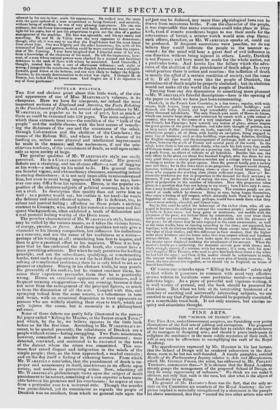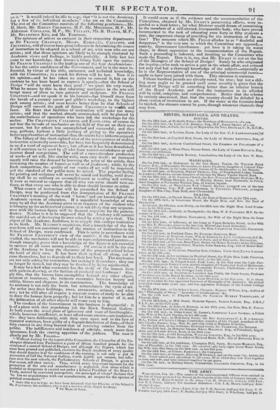FINE ARTS.
THE "SCHOOL OF DESIGN" JOB.
THE Fine Arts, underGovernment auspices, are furnishing very pretty illustrations of the foul arts of jobbing and corruption. The proposed school for teaching the art of design bids fair to exhibit the proficiency of its managers in designing arts ; and should it prove inadequate to enlighten the mechanics in the more subtle mysteries of their craft, it will at any rate be efficacious in exemplifying the craft of the Royal Academy. The apprehensions expressed by Mr. .HAYDON in his last lecture, that the School of Design will be rendered subservient to the Aca- demy, seem to be but too well-founded. A timely pamphlet, entitled Results of the Parliamentary Inquiry relative to Arts and Manufactures, which Mr. GEORGE Fonoo, the artist, has addressed to Mr. FouLerr THOMSON, commences thus—" It is obvious that the Royal Academy already grasps the management of the proposed School of Design, as they do every opportunity of influence." We think we can make it obvious, not only that such is the case, but also what is the object of the Academy in so doing. The ground of Mr. HAYDON'S fears was the fact, that the only ar- tists on the Committee are members of the Royal Academy : the sus- picion implied is materially strengthened by a statement in the pamph- let above mentioned, that they "ousted the two other artists who were on it." It would indeed be idle to (lige, that " it is not the Academy, but a few of its individual members," who are on the Committee. The rest of the Committee consists of the following gentlemen—Mr. H. HOPE, Mr. RIDLEY COLBORNE, M. P. Mr. MonnrsoN, M. P., Mr. Alderman COPELAND, M.P., Mr. PessarT, Mr. B. Hawes, M.P.,
Mr. RELLENDEN KER, and Mr. THOMSON. The opinions of artists so eminent in their respective departments as Sir FRANCIS CHANTREY, Messrs. EASTLAKE, CALLCOTT, and COCKERELL, will of course have great influence in determining the course of instruction to be adopted in a school of art, with men who are not artists ; and that those opinions are likely to be strongly tinctured by Academic views and feelings, is highly probable. A little fact bus come to our knowledge, that throws a strong light upon the matter. Sir FRANCIS CHANTREY is the leading one of the four Academicians : he has the entire confidence of the Government, and he is the most in- fluentiel, by virtue of his title, eminence, and technical knowledge, with the Committee; in a word, his dictiim will be law. Now it is his opinion—and he has taken no pains to conceal it, but on the contrary he has been heard to express it openly—that the School of Design "will do more harm than good :" we quote his very words. What he means by this is, that educating mechanics in the arts will tempt many of them to turn painters and sculptors. Sir FRANCIS CHANTREY—and we speak it to his honour—has himself risen from the beech of a country carver end gilder's workshop, to the highest rank among artists ' • and none knows better than he that Schools of Design will smooth the path of future CHANTREYS to wealth and fame. He fears that facilities of instruction will make too many artists ; and that the market, already overstocked, will be glutted by the contributions of operatives who have left the workshops for the atelier. The CHANTREYS, CALLCoTTS, and EAsTLAKES, of course do not fear the inroads of mechanics on the field of fine art on their own
account, but for others less accomplished and successful ; and they may, perhaps, harbour a little jealousy of giving to the operatives better opportunities of instruction than the artists have hitherto enjoyed. The fallacy of this short-sighted view of the consequences of making
instruction universally accessible, has been too frequently demonstrated
to necd a word of argument here ; but, often as it has been demolished, it will continue to be used by all who from narrow-mindedness or self- interest dread competition. The evil of a superabundant production of works of art will, like similar evils, soon cure itself: an increased supply will raise the demand by lowering the price of the article, thus increasing the number of buyers as well as of producers; while, by the fresh competition, the quality of our works of art will be improved, and the standard of the public taste be raised. The popular feeling for painting and sculpture will never be sound and healthy, until draw- ing shall be as ordinary an accomplish:nem as reading and writing. It were as rational to suppose that all who can write should turn au-
thors, as that every one who is able to draw should become an artist.
What course of instruction will be prescribed for the School of Design, may be predicated from this interpretation of Sir FRANCIS CHANTREY'S meaning of the word "harm," and our knowledge of the Academic system of education. If a superficial knowledge of ana- tomy be all that the Academy gives to or requires of the student who is bringing up for an historical painter, it is not likely that any acquaint- ance with the human figure will be deemed resplisite for the pattern. drawer. Neither is it to be supposed that the Academy will commit the suicidal act of destroying its own school by setting up a rival. The
object of the Academy, doubtless, is to cripple this embryo institution in its birth. Mr. HAYDON'S suspicions, that a knowledge of the ha- man form will not constitute part of the routine of instruction in the School of Design, seem confirmed. This is quite in accordance with Sir FRANCIS CHANTREY'S view of the matter : if the figure be not studied, the mechanics will not be able to turn sculptors and painters,— though examples prove that a knowledge of the figure is not essential to success in all cases among painters. Of course it will be the aim of the Academy to keep the character of the proposed school below the level of their own. It has been their system all along, not to raise themselves, but to degrade all to their low level. The mechanics are not only asking for instruction, but seeking it themselves : they can no longer be denied, but they may be deceived bs. being misdirected. It may be asked what connexion has the study of the human form with pattern-drawing, or the fashion of crockery and hardware ? Sim- ply this, that the human form exemplifies beyond any other object, animate or inanimate, the intimate connexion between beauty and utility, fitness and elegance, it: its construction. The knowledge of its anatomy is not only the basis, but comprehends the cycle of art. An artist may draw buildings, trees, ornaments, animals, and what not ; yet he will after all require a separate course of study to be able to draw the human form properly ; but let him be a master of it, and the delineation of all other objects will come easy to him. The conduct of the Government in this business is disgraceful : it is of a piece with that scandalous job the Mock National Gallery. In both cases the usual pleas of ignorance and want of forethought— which, however insufficient, at least afford some excuse—are inadmissi- ble they have deliberately, with their eyes open and in the face of repeated warnings, been guilty of a flagrant dereliction of duty—if their duty consist in any thing beyond that of receiving salaries from the public. The indifference and indolence of officials, much more than ignorance, feeds the craving appetites of the jobbers. The case is clearly put by Mr. Focoo-
" Without waiting for the report of the Committee, the Chancellor of the Ex- chequer obtained from Parliament a grant of fifteen hundred pounds for the creation of a central School of Design; and although the Report, which has since been printed and published, convicts the Royal Academy of every quality that should deprive it of the confidence of the country, it not only is put in possession of half the National Gallery, worth 2,500/. per annum, but influ- ence over the new schools, the Parliamentary. Schools of Design, is given to that secret, self-elect society. Thus, whilst every important measure fur the promotion of the arts and manufactures is neglected, that alone which is doubtful or dangerous is carried out under a Libel al President of the Board o Trade, assisted by convicted monopolists' the principal of whom* declares that 'he has no acquaintance with our manufactures, no respect for the opinion of political economists.'"
• Since this a as in type, we have Leen informed that the Director of the School is 1Mr. Newowrit, the atchitect, who is not a member of the Royal Academy.
• Sir MARTIN Sure. It would seem as if the evidence and the recommendation of the Committee, obtained by Mr. EWART'S persevering efforts, were re-
garded as a dead letter; for what Minister would dream of committing to the members of a self-elected, irresponsible body, who have proved incompetent to the task of educating even forty or fifty students a year, the important charge of providing for the instruction of the na- tion? The measure which Mr. Foca, alludes to as "doubtful and dangerous," is the very one to which the Committee are opposed,— namely, Government interference: yet here it. is taking its worst shape, in direct opposition to the recommendation of the Report. Such a proceeding is indecent, and insulting to the Committee who made the Report. How is it, too, that Mr. EWART is not on the list of the Managers of the School of Design ? Surely he who originated the inquiry—who took so active a part in the whole affair, and evinced not only zeal but a thorough knowledge of the subject—especially as be is the Representative of one of the principal commercial towns— ought to have been joined with them. This omission is ominous.
Fifteen hundred pounds are already voted, 'tis trite; but not a shil- ling more ought to be granted until some security is given that the School of Design will be something better than an inferior branch of the Royal Academy, and that the instruction to be afforded will be solid, complete, and comprehensive. Better that the scheme be entirely abandoned, than that the country should be deluded by a sham system of instruction in art. If the water at the fountain-head be tainted, the streams cannot be pure, through whatever channels they may flow.



























 Previous page
Previous page